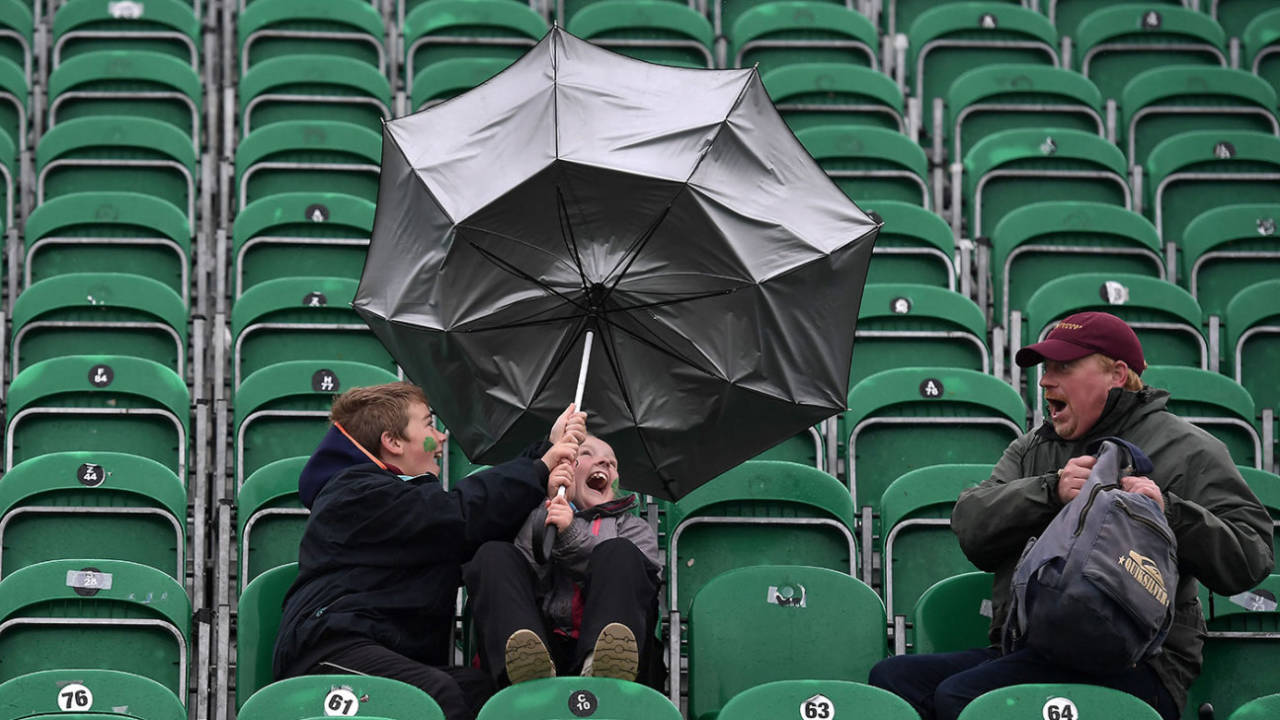What's a washout in the grander scheme of Ireland's cricket history?
Ireland endured a disappointing first day of Test status, but they've endured greater hardships than this in the past
Jarrod Kimber at Malahide
11-May-2018
Not an easy day for using umbrellas • Getty Images
Back in the day, a handful of Irish players would be sent every year to Lord's for a week of training with the MCC. One of those was Doug Goodwin, who had been planning to explore London after a nets session when he was taken aside by one of the coaches and asked if he'd like to bowl to some of the senior members of the MCC.
Goodwin said okay, and was then offered "a couple of coins" to bowl half-volleys outside off, because off-drives were the man's specialist shot. A couple of nights later, he was at it again: another old guy, another few coins, another lot of friendly bowling.
Doug Goodwin captained Ireland, his first-class bowling average was 29, and against West Indies in 1969 he took 5 for 6 in the first innings and 2 for 1 in the second, making that 7 for 7 in the match.
But the only time he got paid was when some old jazz-hat MCC member wanted to look better in the nets.
Irish cricket might have been played for a long time, but there can be few countries where cricket remained as unprofessional, especially despite so many good results. In 1858 they beat the MCC by an innings and ten runs. In 1904 Tom Ross took 9 for 28 against a South Africa team that would beat England in a Test less than two years later. They also beat West Indies in 1928, less than two years after they won their first Test.
But Irish cricket never went beyond club cricket. While other countries had strong boards who pushed for their country, in Ireland, it was never seen as anything more than the odd bit of recreational fun. Ireland's first revolution came in the late-1990s, when the Celtic Tiger economic boom brought money into the club scene, and players like Trent Johnston made club careers in Ireland.
Johnston laughs when asked how professional the warm-up was for the 2007 World Cup. "We would meet at what was called an indoor centre at the time, but it was more like an icebox, out the north of County Dublin. We'd meet at the weekend to bat, bowl, and field with gloves on because it was snowing at the time, and that was only every couple of weeks or once a month, and that's all we did as a group. It was probably minus two outside, and minus ten inside."
Being that it was the 2007 World Cup that changed everything for Ireland, it is a remarkably similar situation to how cricket had been in Ireland years earlier.
Ossie Colhoun was a remarkable wicketkeeper in Sion Mills, and so he got the first call to play for Ireland as a 20-year-old. "When I was first picked, I got a telephone call saying 'congratulations, you're playing for Ireland against Lancashire', and the two opening bowlers were Alec O'Riordan and Raymond Hunter. And I had never even seen them bowl."
Colhoun had no idea how far to stand back, what kinds of bowlers they were. Irish cricket was so segregated by different competitions at that time that, unless you played club cricket with someone, you didn't know them. One day Colhoun was a club cricketer in a small town in Northern Ireland, the next day he was keeping to the greatest seamer Ireland ever had.
Ed Joyce talks about getting letters to inform him he'd been picked for Ireland and that he needed to be at the airport on a particular day where he'd receive his cap and shirts. Raman Lamba caused a stink in Irish cricket when he refused, because he was a professional, to pay for his Irish sweater.
Mike Halliday played for Ireland for over 19 years; he was a captain for about five years, he managed the team after that. His offspin was very good; his first-class average was 26. And now he makes posters about the history of Irish cricket. You would struggle to find a more respected person in their history.
In 1975, Halliday was picked to play a three-day game against Denmark at Ringstead. The team flew there, Halliday only picked up one wicket, batted for 57 minutes for eight runs, and the match was a draw. Later Halliday received a bill for 50 pounds for his airfare.
A few years earlier, when Doug Goodwin was to come to London for a match, the Dublin players caught the boat to Liverpool and then were to catch a train down. Unfortunately, their carriage was cancelled, so without seats, they stood their whole way down and played the next day.
Irish cricketers have overcome many obstacles; a rained-out first day is the least of their worries.
Jarrod Kimber is a writer for ESPNcricinfo. @ajarrodkimber
